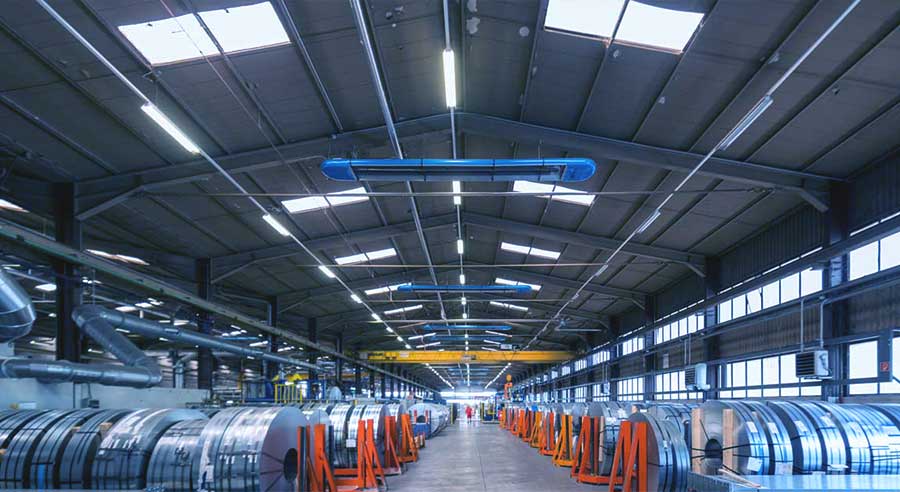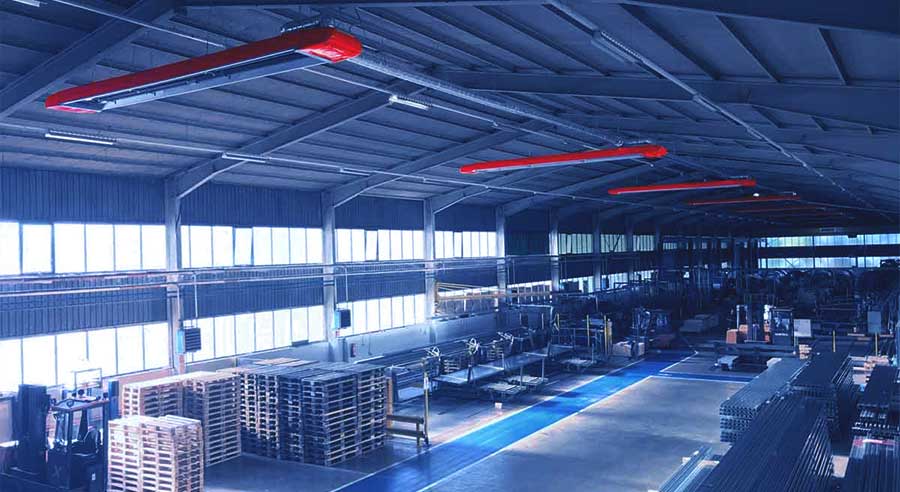Infrared hall heating in your production: how to create the right indoor climate at work
Infrared hall heating in your production: how to create the right indoor climate at work
Hall buildings are a world unto themselves. Especially in winter, their high ceilings pose a real challenge for anyone who wants to ensure the most pleasant possible working environment in the workplace. But there are solutions - for example, infrared hall heating. But first you should ask yourself: what does comfortable indoor climate mean anyway? And what factors are decisive for this? There are various representations of this, which basically boil down to four different factors, which we will introduce to you in this guide.
4 factors that influence a pleasant indoor climate at work
Basically, when it comes to a comfortable indoor environment at work, you should always pay attention to these four factors:
- Temperature
- Humidity
- Air movement
- Air quality
While the temperature depends to a large extent on the type of activity (18 °C sensation temperature is sufficient for physical work, at least 20 °C is necessary for sitting), there is agreement on the factors of humidity, movement and quality of air. 40 - 60 % humidity, an air movement of no more than 0.15 m/s (at 21 °C) and an oxygen content of 21 % are standard values that most people find pleasant and thus constitute the optimum room climate at the workplace.
The right indoor climate in the workplace influences the productivity of your employees
It is a proven fact that a poor indoor climate in the workplace has a negative impact on the willingness and ability of your employees to perform. You notice it at the latest when complaints come in or sick leave increases. Among many other bodies, the German Federal Institute for Occupational Safety and Health (baua) has looked into this and writes about it in a report published in 2016:
"Small deviations from the "climate optimum" initially lead to disturbances of well-being, complaints about the climate (too warm, too cold, there is a draft) are the result. If these effects are amplified and climate monotony or the inability to influence the climate itself is added, this can lead to a high level of dissatisfaction, stress and psychological strain; motivation and satisfaction with one's own work decline. Ultimately, the willingness to exert effort decreases, employees feel less capable, and objectively measurable productivity losses and increased error rates can occur."
The problems you face when you want to create the optimal indoor climate in the workplace
Hall buildings are not easy to heat. Due to the fact that the premises are particularly large and high, it can also be particularly challenging to achieve the ideal indoor climate in the workplace. What problems arise when choosing a hall heating, you will learn below.
Problem 1: The size of hall buildings as the biggest challenge for the indoor climate in the workplace
In offices, it is still relatively easy to positively influence the indoor climate. If, on the other hand, the workplace is a production hall, those responsible face completely different challenges. Because the company's goal of a "good working atmosphere" is facing headwind from various directions:
- Large ceiling heights from 4 to 20 meters and more
- Long gate opening hours
- Different work areas and hall zones
- Different building floor plans and layouts
- Dynamic temperature requirements
- Insufficient insulation, esp. old halls
- High pressure to reduce operating costs
So creating the optimal indoor climate at the workplace is anything but easy in a production hall. Just keeping the temperature in such a building at a comfortable level is not trivial. Especially because good and uniform heating must also be considered against the background of energy efficiency. Not to mention humidity, air movement and air quality.
Problem 2: Not every heater contributes to a good indoor climate at the workplace
A wide variety of technologies are used for hall heating. Not always with the desired result in terms of functionality, thermal comfort and economy. They differ according to the type of energy source (fuel oil, gas, wood, electricity, solar) and the type of supply: centralized or decentralized. Decentralized heated systems are the technology of choice in many applications today. In particular, gas-fired infrared hall heaters of the dark radiator type take a prominent role, because they are specially tailored for heating high spaces, where they offer important advantages.
No hot air: Why infrared hall heaters are so good for the indoor climate in the workplace
Infrared hall heaters are radiant heaters. These heating systems transfer heat by emitting infrared radiation. As soon as the rays hit bodies or objects, they are converted into heat. Thus, the effect of infrared hall heaters is similar to the heat principle of the sun, which heats not the air, but directly people, room frame, machines and other objects in the hall, resulting in a particularly pleasant indoor climate at work.
Radiant heating systems also have a decisive advantage in high rooms: where no air is heated, no warm air can rise high under the hall roof and form unused warm air cushions there - outside the working area. Infrared hall heaters are specially made to bring heat evenly to the area of use. And nowhere else. Incidentally, this is also the decisive reason why these systems are so energy-saving and thus so economical and environmentally friendly.
Infrared hall heaters influence an optimal indoor climate at the workplace in many different aspects
The uniform targeted temperature control is not the only reason why infrared hall heaters provide a pleasant indoor climate in the workplace. By not creating warm air, these systems do not cause unpleasant drafts - and where there is no draft, there is no dust swirl to pollute the air quality. Dust is almost everywhere - so this is an important plus for the well-being and health of your employees as well as for the protection of your production machinery. An advantage for the air quality is also the closed combustion of the infrared hall heating in the form of a dark radiator - and associated with this its property that exhaust air is specifically discharged to the outside and does not remain in the hall building. Incidentally, this waste heat can be used - with increased efficiency - for other thermal processes, e.g. for water heating (keyword: hybrid systems).
How to control good indoor climate at work with infrared hall heating very specifically
Infrared hall heating systems like KÜBLER's technologies are rarely simple stand-alone solutions today. They are digitally integrated into systems that enable a wide range of smart functions. In this way, different areas of use in the halls can be defined, specifically controlled and tempered according to need (keyword: zone heating). Intelligent efficiency modules detect open hall doors, for example, and automatically switch off the heating until the doors are closed again. Depending on the length of the door opening times, significant energy savings can be achieved. Today, switch-on and switch-off times are digitally optimized and entire heating processes are monitored and analyzed for audits, e.g. according to DIN EN ISO 50001. The air humidity can also be regulated - this is useful if you are storing corrosion-sensitive goods such as coils, for example.
Create a pleasant indoor climate at the workplace with KÜBLER infrared hall heaters
Infrared hall heaters can be used to solve the many climatic challenges of hall buildings - after all, they have been specially developed for this particular application and thus contribute a great deal to a pleasant working climate in the workplace. But they are more than the basis for a good and productive indoor climate in the workplace. Rather, infrared hall heaters today are designed to bring maximum energy efficiency to your halls. They are high-performance digital solutions that keep energy consumption so low that they pay for themselves both ecologically and economically. Through low CO2 emissions, favorable operating costs and low TCO (Total Costs of Ownership). That is why they are now one of the central building blocks of a sustainable financial and corporate strategy.
If you too are interested in a hall heating system that not only creates an ideal indoor climate at the workplace but is also environmentally friendly, you should take a look at our KÜBLER infrared hall heaters. With our heating systems, you are not only making the right choice for your employees, but also for the future of the planet.
Heating with infrared radiant heaters: These facts you should know!
A new heating system for your company's production is a decision that needs to be carefully considered. After all, it's not just about warm halls. There is much more to it than that:
- Saving heating costs sensibly
- Increase energy efficiency
- Create thermal comfort at the workplace
- Ensure operational flexibility and
- Meet environmental and legal requirements
Are you thinking about whether infrared radiant heaters are the right choice? Then these following facts should make your decision easier!
How infrared dark radiators work
Before we get into the hard facts, let's first clarify two basic questions and clear up common misconceptions. What are radiant heaters and what distinguishes infrared dark radiators from bright radiators?
Many answers you find on the Internet about this are not very enlightening or are simply nonsense. What is correct is that both light and dark radiators are radiant heaters, since in their case heat transfer is almost exclusively by infrared radiation. For this purpose, natural gas or liquid gas are usually used as energy sources. However, biogas or hydrogen, e.g. from regenerative sources, also have great potential for the future.
Dark radiators use closed combustion in a pipe system. Light radiators work with open combustion. The main difference is therefore in the way the combustion exhaust gases are handled: With light emitters, these initially remain in the hall atmosphere. For this reason, sufficient ventilation must be provided for these systems. In the case of infrared dark radiators, the exhaust air is discharged to the outside via an exhaust system - without polluting the hall atmosphere. This is why the use of dark radiators is the preferred choice in most applications today.
In both systems, the heat generated is directed as infrared radiation into the areas to be heated. Similar to solar radiation, heat is generated as soon as the infrared rays hit bodies or objects. Thus, among other things, the hall floor, the room frame and the people in the working area are heated directly.
The special thing about it: Dark radiators heat by their infrared radiation thus no ambient air, but only directly that, which is to be really heated. Thus there is also practically no warm air, which rises physically conditioned under the hall roof, instead of remaining in the work area. This is precisely the decisive advantage of infrared radiators in terms of efficiency.
No hot air - no air movement
You can't make an omelet without breaking eggs. Or a lot of dust is created. This dust is stirred up by conventional hot-air heating systems often used in halls. This is a problem in many companies, but it can be easily counteracted with infrared dark radiators. These heat no air and therefore no draught can arise or dust can be stirred up. For your employees and visitors, this means a healthy, dust- and draft-free working atmosphere.
Infrared dark radiators heat particularly efficiently
Let's stay briefly with warm air heaters, which are commonly used in industrial and commercial halls. Simple physics quickly makes it clear that these are not particularly efficient for heating large halls: After all, the heated air rises straight up. To ensure that it is warm not only under the roof but also in the actual usable zone of the hall, the air must be continuously reheated. If the hall door is constantly open or the hall is outdated and insufficiently insulated, this results in an enormous waste of energy and money.
Infrared dark radiators, on the other hand, only heat the objects and bodies they hit - as already described. And if no warm air is produced, no warm air can escape. In addition, the operation of dark radiators can be flexibly adapted to a wide variety of situations that arise when working in halls by means of an appropriately intelligent control system:
- Door opening times
- Working and shift times
- Different usable zones of the hall, in which different amounts of heat are also required
Infrared radiant heaters are therefore particularly efficient. Expressed in clear figures: they consume up to 70 % less energy than conventional systems. Modern infrared radiant heaters are therefore currently the most efficient heating systems for industrial and commercial buildings. And this means that you not only recoup the initial costs quickly, but also do something good for the environment.
No need to worry about GEG & Co.: Even high efficiency requirements can be safely met by modern infrared dark radiators.
Speaking of environmental protection: Those who have not taken care of efficient heating systems and other energy-saving measures in their halls in recent years are increasingly being forced into action. In order to achieve the goals of the Climate Protection Plan 2050, the legislator is calling for the economical use of energy in various ways. Important here for Germany, for example, are
- the GEG - Building Energy Act (since 01.11.2020) and
- the CO2 tax (since 01.01.2021).
And as far as energy management certifications are concerned: Anyone who wants to fulfill the audits according to the then valid stricter DIN EN ISO 50001 (2018) after mid-2021 must also fulfill increasing efficiency requirements here.
The GEG, which summarizes the previous complex energy saving laws, demands among other things the increased use of regenerative energy sources. The fact that infrared dark radiators run on gas seems to contradict this. Or?
No, on the contrary. This widespread misconception arose due to misleading wording in the old legislation and still causes some uncertainty. But the fact is: modern infrared dark radiators have always been used in compliance with the law due to their high energy efficiency - in new buildings as well as in renovations. In the GEG, this high efficiency is now increasingly recognized by exempting decentrally heated halls with room heights of more than four meters from the obligation to use regenerative energies. In addition, gas as an energy source not only has a good primary energy factor. Gas is the technology of the future with great potential as soon as power-to-gas, i.e. the production of hydrogen, becomes available in large-scale industrial processes. So gas-fired infrared dark radiators will remain the gold standard for energy-efficient heating of hall buildings in the future. And that pays off in the truest sense of the word.
Dark radiators are an investment that pays off. Right from the start.
One mistake that is made particularly frequently when planning hall heating systems is a failure to look at the big picture. The new devices should be as inexpensive as possible in terms of investment - and this pays off in the long run if the consumption costs are disregarded. After all, a hall heating system consumes x times its investment costs over its life cycle. It is therefore important to focus on life cycle costs. The keyword here is: low TCO - Total Costs of Ownership. You can save (or even spend!) a lot of money at the wrong end without it being really effective in the end.
So which heating system is worth it - even in the long run? The answer is: the heater that best fits your usage profile and meets your economic requirements. Infrared dark radiators are characterized by low investment costs compared to many other systems. This is confirmed by the results of a study we conducted together with the Technical University of Kaiserslautern. Investment costs for the use of regenerative energies such as a heat pump in conjunction with underfloor heating or a wood pellet stove coupled with radiant ceiling panels are between a factor of 1, 8 to 4.0 - on average a factor of 3.0! - higher than for a dark radiator system with residual heat utilization.
Regenerative energies are all well and good in residential buildings, but in halls they clearly lag behind the specially developed dark radiators. This is because regenerative energies differ functionally from classical energy sources in one important point and that is the low temperature level. This low temperature level always ties renewable energies to hydraulic solutions, at the end of which is warm air. And warm air as heat transfer in high spaces is dysfunctional, as we have already seen. Who benefits from generating a lot of renewable energy for a lot of money, which then does not develop the necessary heat at the workplace? Halls have completely different conditions due to the significantly higher rooms.
In addition, infrared dark radiators score - as already mentioned - with high efficiency and low annual energy requirements. The investment costs are amortized after just a few years. A dark radiator therefore clearly pays for itself in most halls.
Achieve personal and energy goals with dark radiators
No matter whether your hall is four, ten or more meters high: dark radiators are a sustainable investment that will not only increase the satisfaction and productivity of your employees, but will also help you meet energy policy targets thanks to their high efficiency. Please feel free to inform yourself here. If you would like to talk about specific plans right now, let's have a conversation and discuss the different requirements of your industry.





